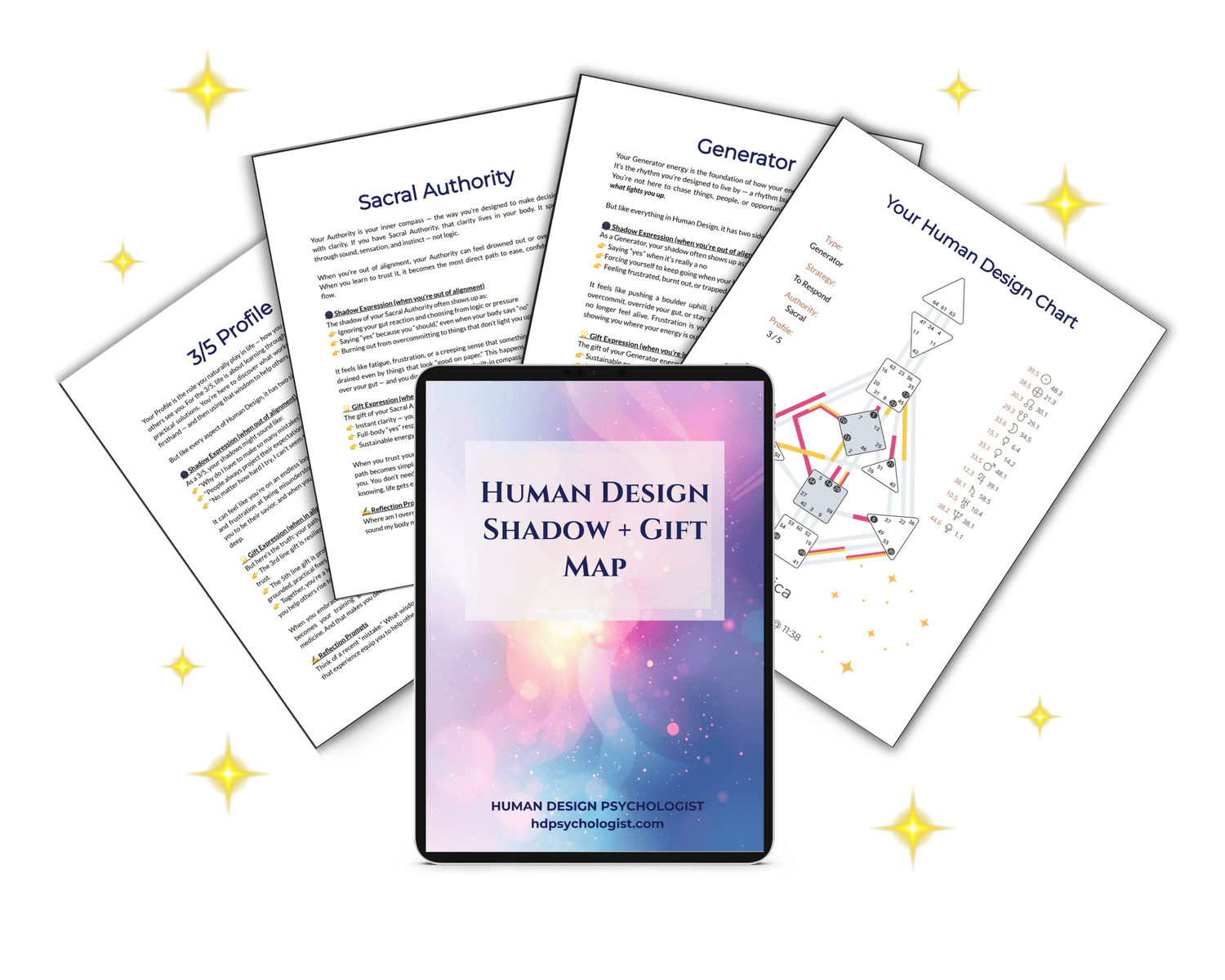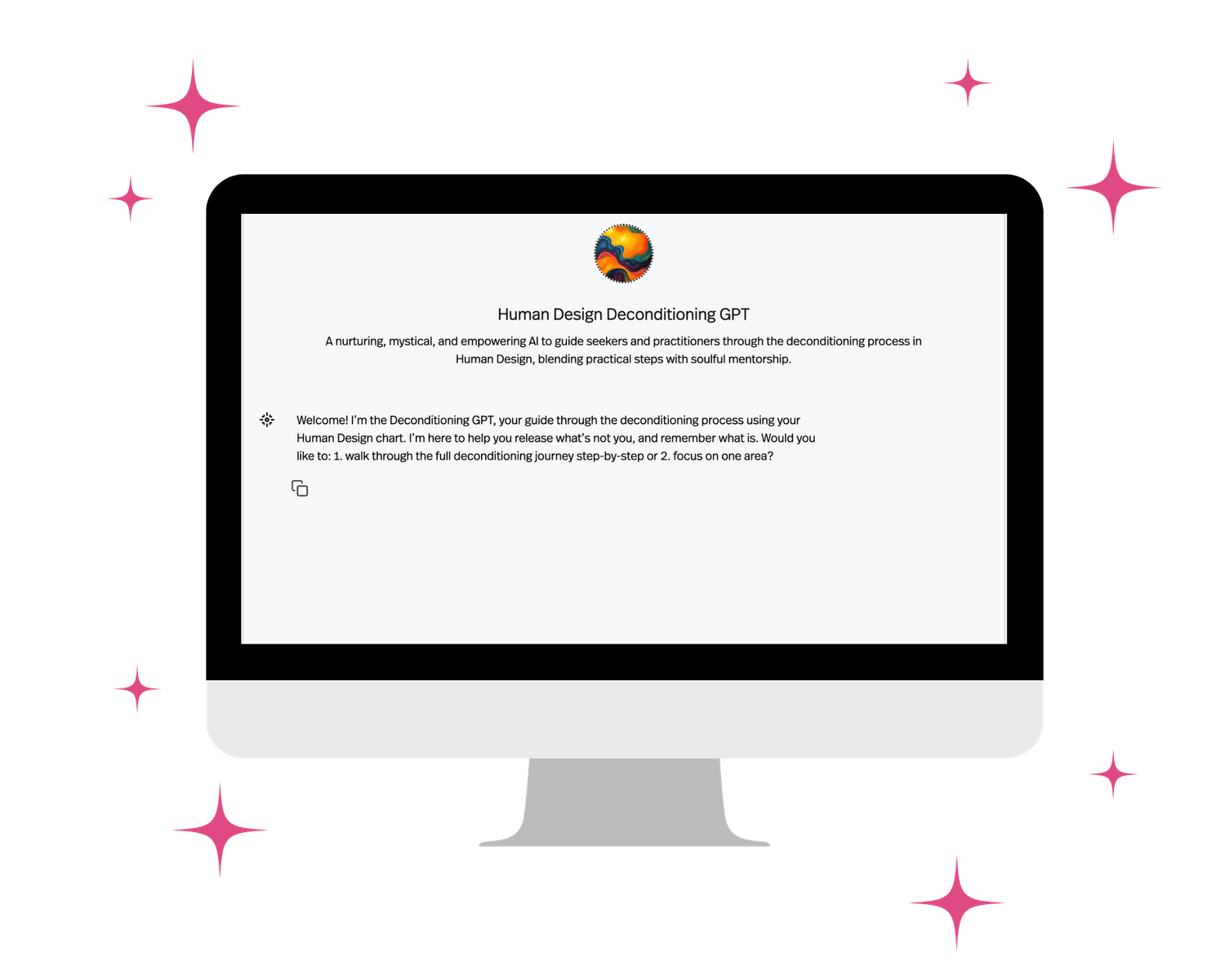How to Decondition in Human Design — Without Overwhelm or Overthinking

You’ve learned what deconditioning in Human Design means: releasing the energy, expectations, and behaviors that don’t belong to you. You understand that it’s not about changing who you are but remembering who you were before the world told you how to be. And yet, once you’ve understood the idea, a question naturally follows — “Okay...but how do I actually do it?”
That’s the moment every Human Design student reaches: when you know what deconditioning is but don’t know how to start doing it. It’s also the point where most people get stuck.
Deconditioning isn’t something you can study or analyze your way through — it’s something you must practice. It’s not a seven-year sentence or a sudden awakening; it’s a daily, embodied experiment that unfolds through awareness, repetition, and gentle trust in your own timing.
In this blog post, we’ll explore what it really looks like to begin deconditioning without pressure or overwhelm. You’ll learn how to anchor into your Type, Strategy, and Authority; recognize where conditioning shows up in your chart; and create simple, repeatable practices that help awareness become embodiment. This isn’t about doing it perfectly — it’s about learning to meet yourself honestly, again and again, until alignment stops being a concept and starts being your lived experience.
Step 1: Anchor Into Your Type, Strategy, and Authority
Every part of Human Design ultimately comes back to these three pillars: your Type, your Strategy, and your Authority. If you learn nothing else and simply practice these, deconditioning begins naturally. These aren’t abstract concepts — they’re the mechanics of trust. They show you how your energy is meant to move, how life communicates with you, and how your body signals truth. Together, they give you a way to stop chasing alignment and start living in rhythm with it.
Your Type: How You’re Designed to Move Through Life
Your Type describes the overall rhythm and pattern of your energy — how you’re built to interact with the world.
Generators and Manifesting Generators thrive through response. You’re designed to engage when something in your environment lights you up — a full-bodied “yes” that your Sacral energy recognizes before your mind can analyze it. When you honor that response, life becomes easier; when you push from logic or pressure, frustration arises.
Projectors thrive through recognition and invitation. You’re not here to chase opportunities or force your wisdom; you’re here to be seen, invited, and valued for your unique perspective. Waiting for recognition isn’t passive — it’s an energetic calibration that ensures your insights land with those ready to receive them.
Manifestors thrive through initiation. You’re here to start movements, not to wait for permission. Your energy comes in bursts — designed to spark momentum. When you inform others before acting, you reduce resistance and create the space to move freely in your creative flow.
Reflectors thrive through reflection. You move best in sync with lunar cycles, taking your time to sample and sense the energies around you. Your clarity comes slowly and rhythmically — waiting allows you to align with what truly feels right.
When you live according to your Type, resistance softens. Energy that was once tangled in frustration or fatigue begins to flow freely again. That alone starts to unwind years of conditioning.
Your Strategy: The Antidote to Forcing
Your Strategy shows you how to harmonize with life instead of trying to control it. Conditioning teaches us to push, plan, and chase; Strategy teaches us to listen. When you follow your natural process — responding (Generator/MG), waiting for the invitation (Projector), informing before initiating (Manifestor), or waiting through the lunar cycle (Reflector) — you align with timing that’s larger than your mind’s agenda. You stop trying to make life happen and start letting it unfold through you.
Your Authority: The Compass You Can Trust
If your Strategy is how you move through life, your Authority is how you decide once life presents an opportunity. Your Authority speaks through your body — not your logic — and learning to hear it is the essence of deconditioning.
Emotional Authority: Clarity comes with time. Ride your emotional wave before deciding; what feels true in calm will always be clearer than what feels urgent in the peak of emotion.
Sacral Authority: Trust your gut responses in the moment — the simple “yes” or “no” that your body knows immediately.
Splenic Authority: Your intuition speaks quickly and quietly, often once. Learn to listen and trust the first nudge.
Ego Authority: Decisions are guided by authentic desire — what you genuinely have the will and heart for, not what you “should” do.
Self-Projected Authority: Speak your thoughts aloud; truth reveals itself through your voice.
Environmental (Mental) Authority: Gain clarity through conversation and observation; let neutral environments and trusted sounding boards help you hear yourself.
Lunar Authority (Reflectors): Move with time. Allow the full lunar cycle to reveal what’s true.
When you follow your Strategy and Authority, you naturally begin to decondition. Every time you choose your body’s wisdom over your mind’s pressure, you re-establish trust in your own design.
A Simple Daily Practice
Before making your next decision — big or small — pause and ask,
“Am I moving from pressure, or from my Strategy and Authority?”
That one question can change everything. Deconditioning doesn’t require control or discipline — only a willingness to return to connection, again and again.
🌟 Unsure how conditioning might show up in your unique chart?
Get your FREE Human Design Shadow + Gift Map by signing up below — a personalized guide that shows how your unique energy expresses both its shadows and gifts across your Type, Strategy, and Authority. 👇

Step 2: Spot the Conditioning Traps in Your Human Design Chart
Deconditioning begins with awareness — not action. You can’t release what you haven’t yet recognized. Before trying to change anything, start by gently observing where conditioning shows up across your entire design. It doesn’t live in just one part of your chart; it can weave itself through every layer of your energy system.
Where Conditioning Lives in Your Human Design Chart
Every Human Design chart is a living network of energy — including your Type, Authority, Centers, Channels, Gates, and Profile — all interacting to shape how your energy moves through the world. When you begin deconditioning, you’re not working with one isolated piece of the chart; you’re untangling all the ways your system has adapted to survive in a world that hasn’t always supported your natural rhythm.
Defined Centers — Conditioning Through Rigidity
Your defined centers are where your energy is consistent and self-sourced. These are your natural strengths — the parts of you you can always rely on. When conditioning touches a defined center, it often shows up as rigidity: clinging to what’s familiar, needing to be “right,” or over-expressing that energy to prove something. For example, a defined Throat might push to speak or perform rather than wait for natural timing, while a defined Heart might over-commit in order to demonstrate value.
Open or Undefined Centers — Conditioning Through Absorption
Your open and undefined centers are where you’re most receptive. You naturally take in, amplify, and reflect energy here. This sensitivity is one of your greatest teachers — it shows you the full range of human experience — but when you identify too strongly with what you absorb, that borrowed energy begins to shape who you think you are. Over time, you may chase what isn’t yours, suppress what is, or confuse other people’s emotions, fears, or urgency as your own truth.
Channels and Gates — Conditioning Through Repetition
Conditioning can also thread through your channels and gates — the pathways that carry energy between centers. A channel blends two themes; if one end is open (a “hanging gate”), that end can become especially sensitive to the energy of others, pulling conditioning through the entire connection. Repeated exposure creates energetic habits that feel automatic but aren’t truly aligned. Gates can hold similar imprints, particularly those linked to open centers or activated by planetary transits or relationships.
Profile — Conditioning Through Identity
Your Profile describes how you’re designed to move through life and connect with others. Each line carries both a gift and a conditioned behavior that forms when your natural expression is misunderstood or shamed. For instance, a 1-line might become defensive about “not knowing enough,” or a 4-line might overextend in relationships to maintain belonging. Deconditioning allows each line to soften back into its true gift — curiosity, connection, or wisdom that feels effortless again.
Type and Authority — Conditioning Through Disconnection
Conditioning also shows up whenever you ignore or mistrust your Strategy and Authority — the core mechanics of alignment. When that happens, you experience your Not-Self theme: frustration for Generators, anger for Manifestors, both frustration and anger for Manifesting Generators, bitterness for Projectors, and disappointment for Reflectors. These emotions aren’t flaws; they’re feedback. They let you know you’ve temporarily stepped out of your natural flow.
How Conditioning Feels in Real Life
You don’t need to analyze every part of your chart to start noticing conditioning. Look for the patterns that leave you tense, tired, or disconnected: saying yes when your body says no, rushing through tasks, seeking approval, overthinking, or holding on when you need to release. Each of these is simply a signal that borrowed energy has taken the wheel for a moment.
Practice: The Awareness Journal
At the end of each day, note one moment when you felt pressured or out of sync. Ask yourself:
– “Whose energy was I carrying?”
– “What did my body want in that moment?”
You’re not judging yourself — you’re training your awareness to recognize conditioning as it happens. Over time, this soft noticing rewires your nervous system to trust your own rhythm again.
Deconditioning doesn’t happen through force or analysis. It happens through noticing — quietly, repeatedly — until your body remembers what authenticity feels like.

Step 3: Create Personal Deconditioning Practices That Fit Easily Into Your Life
Once you begin noticing where conditioning shows up, the next step is to meet it — softly, consistently — in your everyday life. What matters most is that the practice feels natural enough to repeat, because repetition is what teaches the body that it’s safe to live differently.
Keep It Simple and Repeatable
Small practices done consistently will always create more change than complex rituals done occasionally. Choose one or two daily anchors that help you reconnect with your body before the mind takes over.
Morning Check-In
Before reaching for your phone, pause with one hand on your body and ask:
“What do I need today — rest, movement, quiet, connection?”
Let your Authority answer before your mind tries to decide. This single moment sets your energy for the day.
Pause Before “Yes”
When someone asks for your time, help, or energy, take one slow breath before responding. Notice what happens inside — expansion or tension. That micro-pause gives your body the space to speak honestly.
Not-Self Noticing
When frustration, anger, bitterness, or disappointment arises, name it quietly:
“Conditioning is speaking right now.” Acknowledging it without judgment loosens its grip.
Evening Reflection
Before bed, ask yourself: “Where did I override myself today? Where did I honor my energy?”
Write a single sentence. Over time, these small reflections build an honest record of awareness.
Make It Yours
No two designs decondition the same way. Copying someone else’s routine is just another form of conditioning.
Generators and Manifesting Generators often regulate best through movement or creative engagement.
Projectors thrive on rest, reflection, and gentle self-recognition.
Manifestors reset through solitude and spontaneous action that feels self-directed.
Reflectors realign through stillness, nature, and time to sense what’s theirs.
Follow what genuinely nourishes you, not what looks productive.
Your Body Leads the Practice
If your deconditioning work ever feels tight, pressured, or performative, pause. That tension is the mind trying to manage what only the body can lead. True deconditioning feels like exhaling — spacious, grounded, and real.
Step 4: Reconnect With Your Body (Where Real Deconditioning Happens)
Deconditioning isn’t an intellectual exercise — it’s a somatic one. You can’t think your way into alignment; you have to feel your way there. The mind wants to manage, label, and track progress, but the body already knows. It’s been communicating through sensations and emotions all along: tension and ease, contraction and expansion, restlessness and calm. When you begin listening to those cues instead of overriding them, your design starts to come alive.
The Body Speaks Through Sensation and Emotion
When something is correct for you, your body naturally relaxes. When it isn’t, it tightens or withdraws. This is your most reliable feedback system — your built-in Authority in motion.
Emotions carry messages too. Each Human Design Type has a familiar emotional pattern that surfaces when you’ve drifted from alignment:
Generators feel frustration when they push instead of respond.
Manifesting Generators often feel both frustration (from forcing) and anger (from being interrupted or restricted).
Projectors feel bitterness when they offer energy or insight without recognition.
Manifestors feel anger when autonomy is blocked.
Reflectors feel disappointment when expectations or environments no longer mirror truth.
These emotions aren’t problems; they’re signals. They show where your nervous system has slipped into old safety patterns — where conditioning has taken the wheel for a moment. When you meet those feelings with curiosity rather than judgment, they become doorways back to awareness.
Practice: The 60-Second Reset
Once or twice a day, stop for one minute. Close your eyes and ask:
“Where does my body feel tight? Where does it feel open?”
You’re not trying to fix anything. Simply notice. This act of noticing re-establishes safety in the body and begins to unwind the reflex to override your truth.
Safety Before Change
Real deconditioning can only happen when the body feels safe. You can’t integrate new patterns while you’re braced for impact. If you catch yourself trying to get it right, pause, breathe, and soften. That pause is the practice. Each time you choose stillness over self-correction, you teach your nervous system that authenticity is safe.
You don’t have to make your body trust you — you show it, gently, through consistency and kindness. Awareness, breath, and emotional honesty are the most powerful deconditioning tools you have.

Step 5: Embody Your True Gifts, Not Your Shadows
In Human Design, shadows are the conditioned expressions of your energy — the ways your natural gifts distort when shaped by fear, pressure, or external influence. They’re not flaws to fix, but signals showing where your energy has been trying to stay safe.
Every shadow in your chart carries a gift — the same energy, simply expressed from awareness rather than survival. Deconditioning isn’t about eliminating your shadows or correcting your flaws. It’s about seeing how each one has been trying to protect you, and then allowing it to evolve into its true purpose.
When you meet your conditioned patterns with judgment, they harden. When you meet them with awareness, they soften — and what’s revealed underneath is the gift that’s been waiting all along.
From Distortion to Expression
Each Type, Profile, Center, Gate, and Channel holds a frequency spectrum. At one end is the shadow — how that energy behaves when influenced by fear, pressure, or external conditioning. At the other is the gift — how that same energy expresses itself when you’re aligned with your natural rhythm.
For example:
The open Head Center that once chased answers becomes a source of inspiration, curious about life instead of needing certainty.
The defined Ego Center that once overworked to prove its value becomes a beacon of integrity and self-trust.
The Root Center that once raced under pressure becomes steady, channeling its drive into grounded momentum.
The Projector’s wisdom that once felt unseen becomes magnetic when offered through rest and recognition.
You don’t transcend your shadows; you integrate them. The parts of you that were shaped by conditioning are the same ones that carry your wisdom.
Step 6: Be Consistent With Integrating
Deconditioning doesn’t happen in a single breakthrough moment — it unfolds through gentle repetition over time. Awareness turns into embodiment through consistency.
The mind often wants evidence — something to prove that you’re “doing it right.” But Human Design isn’t about performance. It’s an experiment, which means the goal is curiosity, not perfection. The point is not to stay in alignment at all times, but to keep noticing when you’re not — and to return gently, without judgment.
Create Rhythms That Support You
Integration thrives on rhythm, not rigidity. A few minutes of awareness each day is more powerful than occasional bursts of insight. Build consistency through simple, repeatable actions:
A short morning check-in to feel your energy before the world rushes in.
A midday pause to breathe and ask, “Am I following my Strategy and Authority?”
A brief reflection at night: “Where did I override myself today? Where did I trust myself instead?”
These small acts become your nervous system’s new language of safety. Over time, you won’t need to “practice” them — they’ll simply become how you move through life.
Stay in Experiment Mode
Human Design was never meant to be memorized; it was meant to be lived. Every interaction, decision, and emotion offers feedback about how your energy moves. If you treat your deconditioning as an experiment, not a test, you can stay open to what life is showing you. The more curious you remain, the more your body — and not your mind — becomes the authority in your life.
The Truth About the "7 Year Deconditioning Process"
In original Human Design teachings (from Ra Uru Hu), the “seven-year deconditioning process” isn’t a rigid rule or fixed timeline. It’s a biological metaphor — a reference to how long it takes for the human body to renew all its cells. The idea is that when you start living according to your Strategy and Authority, your entire system — physical, emotional, energetic — gradually reorients itself.
In other words, seven years is not a countdown to perfection. It’s an approximate rhythm for full cellular renewal — a reminder that genuine transformation happens slowly, through consistent awareness and lived experience.
Conclusion: Living the Practice
Deconditioning isn’t something you master — it’s something you live. It unfolds in quiet, consistent moments of awareness: a breath before saying yes, a pause before proving, a return to trust when your mind wants control. Over time, those small choices add up. Life begins to feel more spacious, more honest, and more like you. That’s the real point of Human Design — not to perfect yourself, but to come home to yourself.
🌟 Want even MORE support on your deconditioning journey?
Check out The Deconditioning Companion GPT, an AI-powered companion that walks you through my own tried-and-true deconditioning process step-by-step. 👇

Hi, I'm Nicole!

🌟 I'm a psychologist, teacher, Human Design coach and educational consultant. 20+ years working with kids and adults in public and private settings and Ph.D.-trained. Lover of Christmas, the beach, and experiments. 3/5 Emotional Manifesting Generator. 🌟
GET UPDATES FROM ME
Copyright 2025 Human Design Psychologist
CONTACT
hi@hdpsychologist.com
770 Sycamore Ave., Ste. 122 #117, Vista, CA 92083
HOME | ABOUT | TERMS | PRIVACY POLICY | DISCLAIMER


